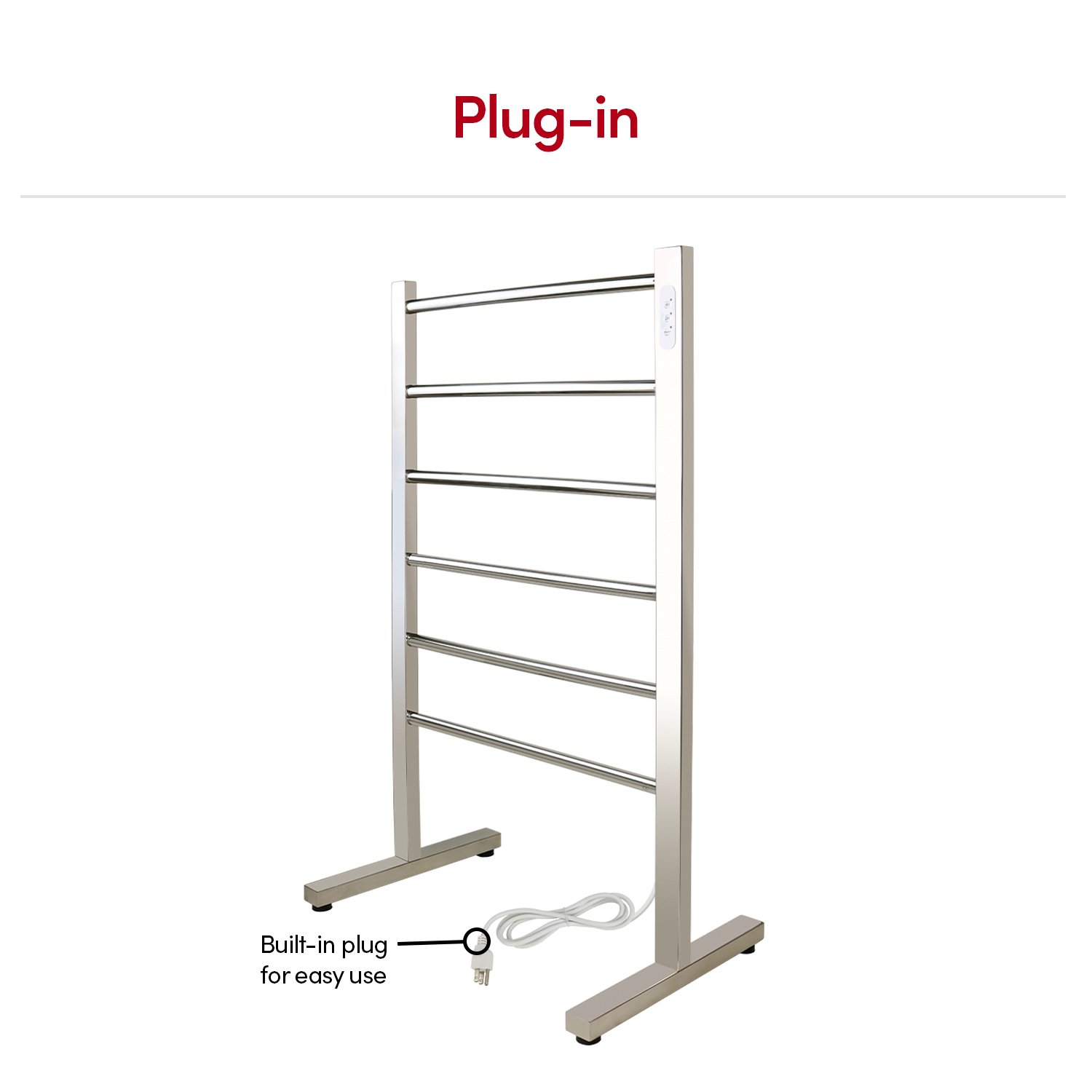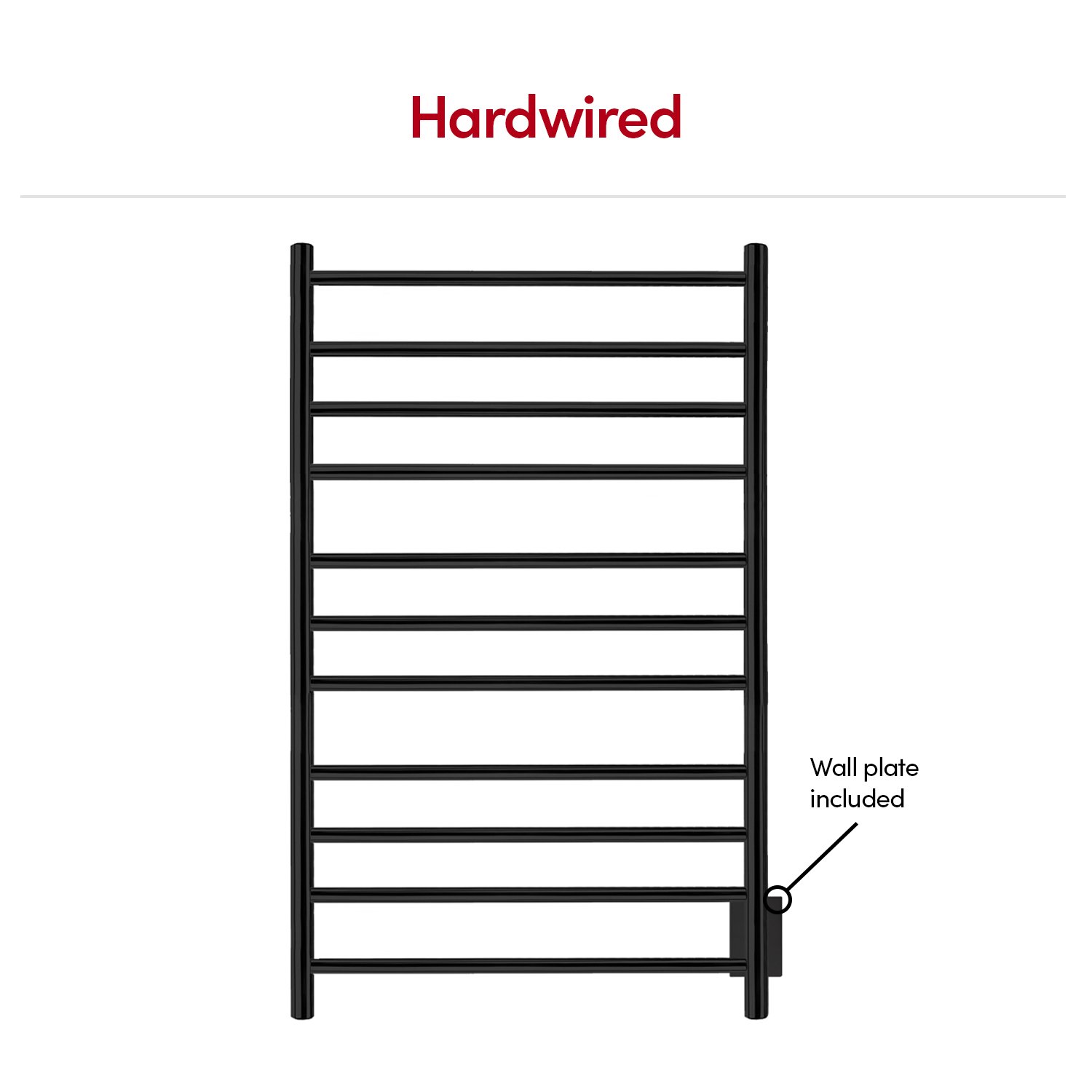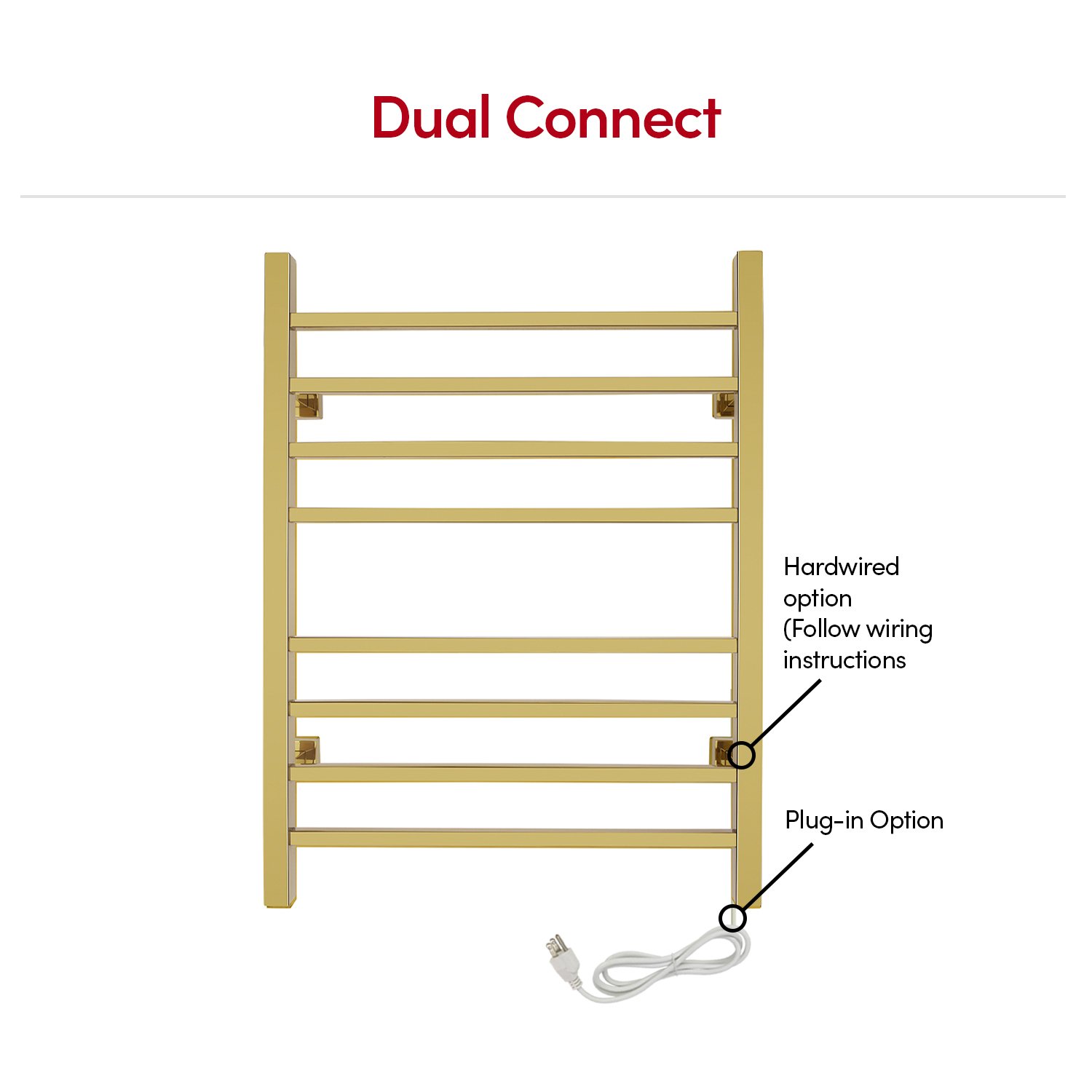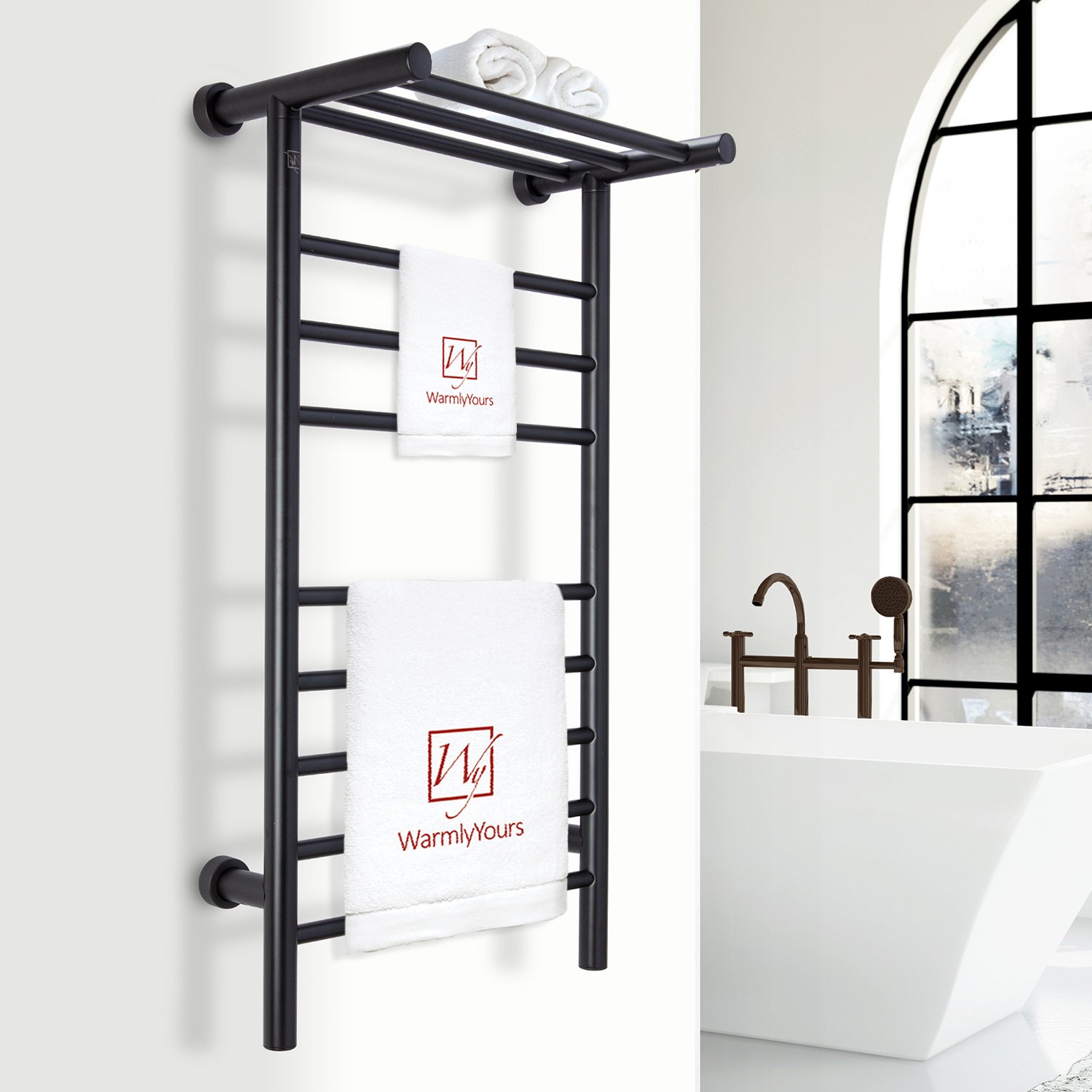Towel warmers are often associated exclusively with warming bathroom towels, but their functionality extends far beyond this singular use. Beyond the bathroom, these versatile devices can be utilized to warm swimsuits, dry delicate clothing, or even heat blankets and robes, enhancing comfort throughout the home. Additionally, when in operation, towel warmers contribute supplemental heat to the room, aiding in maintaining a cozy environment and potentially reducing overall heating costs.
Towel Warmer Tips: Where, When, and How to Use It
Towel warmers—also known as heated towel racks—are versatile additions to any home. While they’re most commonly installed in bathrooms, their placement depends on your space and needs. Nearly every home with a shower or tub is a great candidate for a towel warmer. If you have an unused section of wall or an existing non-heated towel bar, it can often be replaced with an electric model without taking up additional space. This makes upgrading both easy and practical.

Towel warmers give homeowners the everyday luxury of wrapping up in a warm towel or hand towel after a shower or bath—bringing added comfort and a touch of spa-like relaxation to daily routines. Most models are constructed from low-maintenance stainless steel, making them both durable and easy to care for. In addition to warming towels, they provide gentle supplemental heat to the room, which is especially beneficial in bathrooms with cold tile floors.
While towel warmers are most commonly found in bathrooms, their functionality extends far beyond that. These versatile appliances bring comfort and convenience to a variety of spaces throughout the home:
• Mudroom or Laundry Area: Perfect for drying wet coats, hats, gloves, or delicate laundry items. A towel warmer in this space helps reduce drying time and keeps outerwear warm and ready during colder months.
• Sunroom: In cooler seasons, a towel warmer can provide a touch of supplemental heat, making the space more enjoyable year-round. It’s also great for warming throw blankets to cozy up with during a chilly afternoon.
• Indoor Pool Area (Lucky you!): Ideal for drying swimsuits and towels after a swim, a towel warmer eliminates the need to haul wet items to the laundry room and ensures you always have a warm towel waiting post-dip.
Keep in mind, towel warmers work best with towels and fabrics made from natural materials. Avoid using microfiber or synthetic quick-dry towels, as these are not recommended for heated racks.
The Benefits of Owning a Towel Warmer
Electric towel warmers offer a range of benefits that enhance both comfort and functionality in your home:
• Increased Comfort: Experience the luxury of wrapping yourself in a warm, cozy towel after every shower or bath, elevating your daily routine.
• Convenience: Beyond warming towels, these devices efficiently dry delicate clothing, warm swimsuits, and dry wet coats and gloves, showcasing their versatility.
• Energy Efficiency: Designed with low energy consumption, most towel warmers operate at minimal cost, making them an economical addition to your home.
• Supplemental Heat: They contribute additional warmth to the room, aiding in maintaining a comfortable temperature, especially in cooler months.
• Drying Efficiency: By reducing drying time for towels and other damp items, towel warmers help prevent the growth of mold and mildew, promoting a healthier environment.
Incorporating an electric towel warmer into your home not only adds a touch of luxury but also offers practical advantages that enhance your daily living experience.
Exploring Towel Warmer Options: Plug-In, Hardwired, and Dual Connect Models
Towel warmers are a luxurious and functional addition to modern bathrooms, providing the comfort of warm, dry towels while also contributing to the overall warmth of the space. They come in various designs and installation types to suit different preferences and requirements.
Types of Towel Warmers:
1. Plug-In Towel Warmers: These models are equipped with a standard electrical plug, allowing for straightforward installation by connecting to an existing electrical outlet. They are ideal for those seeking a quick and non-invasive setup. Freestanding towel warmers can be really good options if your power source is distant so that you can move the towel warmer within arm's reach before you get in the shower and then move it back when you're done. They're also great for renters since they don't require any modification to the wall for their installation--you can simply set them where you need them and plug them in. However, the visible cord may not appeal to everyone and could influence the bathroom’s aesthetic.

2. Hardwired Towel Warmers: These units are directly connected to the home’s electrical system, offering a seamless and cord-free appearance. Installation requires professional assistance to ensure compliance with electrical safety standards. Hardwired towel warmers provide a clean and integrated look, enhancing the bathroom’s design. If you want a clean, sleek look without any wiring showing, a hardwired towel warmer is for you. The wiring for these models is tucked away entirely within the wall.

Dual Connect Towel Warmers:
For those seeking flexibility, Dual Connect Towel Warmers present an innovative solution. These versatile units are designed to accommodate both plug-in and hardwired installations, allowing homeowners to choose the method that best fits their needs and bathroom layout. Initially configured for plug-in use, they can be converted to a hardwired setup by a licensed electrician, ensuring adaptability for future renovations or preferences.

An example of such a product is the WarmlyYours Summit Dual Connect Towel Warmer, which offers the convenience of dual installation options along with efficient heating capabilities.
When selecting a towel warmer, consider factors such as installation preferences, aesthetic appeal, and functionality to choose the model that best complements your bathroom’s design and meets your comfort needs.
Installation Considerations for Towel Warmers
Proper installation of a towel warmer is essential for optimal performance and safety. Below are key factors to consider:
1. Location
• Safety Zones: Install the towel warmer in compliance with local electrical codes, ensuring it is placed in appropriate bathroom zones to minimize exposure to water.
• Height Placement: Mount the unit at a height that prevents accidental contact, typically at least 600 mm (approximately 24 inches) above the floor.
• Accessibility: Position the towel warmer within easy reach of the shower or bathtub for convenience, while ensuring it does not obstruct movement within the space.
2. Electrical Requirements
• Power Supply: Verify that your electrical system can support the towel warmer’s voltage and wattage requirements. Most models operate on a 120V AC supply at 60Hz.
• Circuit Protection: Install the towel warmer on a circuit equipped with a Ground Fault Circuit Interrupter (GFCI) to enhance safety by shutting off power if an electrical fault is detected.
• Professional Installation: Engage a qualified electrician for installation to ensure compliance with safety standards and proper grounding.
3. Safety Features
• Overheat Protection: Select models equipped with overheat protection to prevent the unit from exceeding safe temperatures, reducing the risk of burns or fire hazards.
• Ingress Protection (IP) Rating: Choose a towel warmer with an appropriate IP rating, such as IP44, indicating protection against water splashes and suitability for bathroom environments.
By carefully considering these factors and adhering to manufacturer guidelines, you can ensure a safe and efficient installation of your towel warmer, enhancing both comfort and functionality in your bathroom.
For a detailed guide on installing a hardwired towel warmer, please refer to the following video:
Control Options for Towel Warmers
WarmlyYours towel warmers are designed with user-friendly control options to enhance convenience and energy efficiency. Each unit comes equipped with an integrated on/off switch, allowing for straightforward manual operation. Beyond this basic feature, various advanced control mechanisms are available to suit different preferences and schedules:
• Hardwired 4-Setting Countdown Timer: This control offers four preset heating durations—30 minutes, 1 hour, 2 hours, and 4 hours. It’s ideal for users who prefer the towel warmer to operate for a specific period before automatically shutting off, ensuring towels are warm when needed without unnecessary energy consumption.
• Hardwired Programmable Timer: For those seeking a customized schedule, this timer allows programming of up to 50 distinct on/off events per week. It features an easy-to-read backlit LCD screen and an astronomical clock that can be set according to your time zone’s sunrise and sunset times, providing precise control over the towel warmer’s operation.
• Hardwired WiFi Switch: Integrating modern technology, this switch enables remote control of the towel warmer via smart devices. Compatible with platforms like My Leviton, Amazon Alexa, Google Assistant, Apple Home/Siri, Schlage, SmartThings, and IFTTT, it allows users to operate the towel warmer through voice commands or mobile apps, offering unparalleled convenience.
Selecting the appropriate control option enhances the functionality of your towel warmer, aligning its operation with your lifestyle and promoting energy efficiency.
Hydronic Towel Warmers or Electric Towel Warmers?
If the price of a towel warmer is more affordable than you thought, it’s time to narrow down your options. There are two types of heated towel racks on the
When selecting a heated towel rack, it’s essential to understand the two primary types available: hydronic and electric. Each offers distinct features, installation requirements, and benefits.
Hydronic Towel Warmers
Hydronic towel warmers are integrated into your home’s hot water or hydronic heating system, allowing hot water to circulate through the towel rack. This design enables them to deliver a higher heat output, typically around 1,200 BTUs per hour. This substantial heat output not only warms and dries towels effectively but also contributes to heating the bathroom space, enhancing overall comfort.
Electric Towel Warmers
Electric towel warmers utilize an internal heating element powered by electricity to warm the rack. Their heat output can vary significantly based on design and wattage, generally ranging from 100 to 200 watts. This translates to approximately 341 to 682 BTUs per hour, which is typically sufficient for warming towels but may have a limited impact on the overall room temperature.
When choosing between hydronic and electric towel warmers, consider the following:
• Installation Requirements: Hydronic models require integration with your home’s plumbing and heating systems, making them more suitable for new constructions or major renovations. Electric models offer more straightforward installation options, especially plug-in versions.
• Energy Efficiency: Hydronic towel warmers can be more energy-efficient if your home’s heating system operates consistently during colder months. Electric models provide targeted heating and can be used independently of your central heating system.
• Heat Distribution: If you’re looking for a towel warmer that also serves as a space heater, a hydronic model with its higher BTU output may be more appropriate. However, if the primary goal is to warm towels, an electric model may suffice.
Are Towel Warmers Worth the Investment?
If you’re considering enhancing your home with a towel warmer, you might be curious about the associated costs and whether it’s a worthwhile addition. At WarmlyYours Radiant Heating, towel warmers range in price from $165 to $650, depending on the style and features you select.
As of December 2024, the average residential electricity rate in the United States was 16.26 cents per kilowatt-hour (kWh). Operating a towel warmer with a power rating of 150 watts (0.15 kW) for one hour consumes 0.15 kWh. At this rate, the cost to operate the towel warmer for one hour is approximately 2.44 cents (0.15 kWh * 16.26 cents/kWh). If the towel warmer is used for 2 hours daily, the daily operating cost would be about 4.88 cents, leading to a monthly cost of approximately $1.46. This calculation demonstrates that towel warmers are energy-efficient appliances, adding comfort to your home at a minimal cost.
The combination of these benefits—enhanced comfort, versatility, energy efficiency, supplemental heating, and improved hygiene—alongside the low daily operating cost, makes towel warmers a worthwhile investment for homeowners seeking to add comfort, luxury, and convenience to their daily routines.
Selecting the Ideal Towel Warmer for Your Home
Choosing the perfect towel warmer involves evaluating several key factors to ensure it meets your functional needs and complements your home’s aesthetics.

1. Assess Your Space
• Bathroom Dimensions: Measure your bathroom to determine the appropriate size of the towel warmer. Ensure it fits comfortably without overcrowding the space.
• Available Wall Space: Identify suitable wall areas for mounting, keeping in mind the warmer’s projection to maintain clear pathways.
2. Determine the Type
• Wall-Mounted: Ideal for saving space, these models are fixed to the wall and can serve as a focal point in bathroom design.
• Freestanding: Offering flexibility, freestanding warmers can be moved as needed and require no installation.
• Hydronic vs. Electric:
• Hydronic: Connected to the home’s hot water system, providing consistent heating but may require professional installation.
• Electric: Operates independently via electricity, available in plug-in or hardwired options, and is generally easier to install.
3. Style and Finish
• Design Aesthetics: Choose a style that aligns with your bathroom’s décor, whether traditional, modern, or contemporary.
• Material and Finish: Options include polished chrome, brushed nickel, matte black, and more. Select a finish that complements existing fixtures and is easy to maintain.
4. Heating Capacity and Energy Efficiency
• Heat Output: Ensure the warmer provides sufficient heat for your towels and contributes to the room’s warmth if desired.
• Energy Consumption: Look for energy-efficient models to minimize operating costs. Features like timers or thermostats can enhance efficiency by allowing you to control usage.
5. Budget Considerations
• Cost vs. Features: Determine your budget and find a model that offers the best combination of features, quality, and value within your price range.
By thoughtfully considering these aspects, you can select a towel warmer that enhances your daily routine with comfort and luxury while seamlessly integrating into your home’s design.
Click here to learn more about WarmlyYours towel warmers.
Frequently Asked Questions (FAQs)
Here are some of the most common questions we get about towel warmers.
Can I use a towel warmer to dry wet towels?
Yes, towel warmers can be used to dry wet towels.
How long does it take for a towel warmer to heat up?
The time it takes for a towel warmer to heat up varies depending on the model's heat output and surface area along with the material of the towel itself. On average, most towel warmers take between 15 to 30 minutes to reach their maximum temperature. The towels themselves will take a bit longer than that to get up to temperature.
Can I leave my towel warmer on all the time?
Yes, and while it is safe to leave your towel warmer on for extended periods, it is more energy-efficient to use a timer or programmable control to energize the device based on your daily routine and usage needs.
Are towel warmers safe to use in a bathroom?
Yes, towel warmers are specifically designed for use in bathrooms and are safe when installed and used according to the manufacturer's guidelines.
How do I clean my towel warmer?
To clean your towel warmer, simply wipe it down with a soft, damp cloth. For stubborn stains, use a mild soap solution and dry thoroughly. Avoid using abrasive cleaners or harsh chemicals, as these can damage the finish of your towel warmer.




